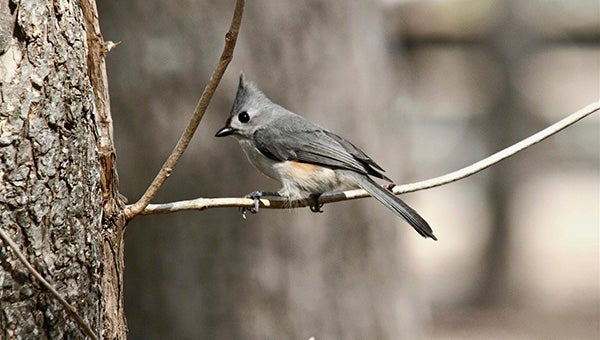Arboretum Paths: Mixing up bird butter at the Arboretum
Published 7:00 am Wednesday, January 13, 2016

The tufted titmouse is a winter resident bird in Mississippi that you might spot at your backyard feeder. (Photo source: U.S. Fish & Wildlife Service Digital Image Library, photographer Robert Burton)
Do you enjoy watching birds at your feeder in winter? At our Arboretum bird programs, avid birder, Audubon member, and author Susan Epps always makes the point that the best all-around bird food you can bring home for them is black oil sunflower seed (not the black and white striped seed, cheaper but not as desirable).
Black oil sunflower seed has a very high fat content, which is especially valuable for feeding birds during the winter months. Many birdseed mixtures, Susan cautions, contain large amounts of cheap fillers, such as red millet, ignored by many bird species.
A bird feeder does not need to be a complicated or expensive to be functional. At the Arboretum, we have several feeders that are simply a plank nailed to the top of a post. This type of feeder is quick to construct, and provides a fine stage for viewing the antics of the feeding birds.
A children’s workshop this Saturday will focus on creating “wildlife ornaments” to will attract birds and other wildlife to your yard. Black oil sunflower seed will be one of the ingredients in the mixture we will use to fill the ornaments. We will whip up a batch of “bird butter”, and use this to fill pinecones to provide a tasty feast for birds and other critters.
Many recipes for bird butter may be found on the Internet. Generally, the concoction consists of a base of vegetable shortening with add-ins such as cornmeal, cracked sunflower seed, oats, raisins, and cranberries.
Vegetable shortening will be the base for our bird butter in lieu of using animal fats such as lard or beef fat because we have such warm coastal winters. When temperatures are above freezing, animal suet can quickly become rancid and can be harmful to birds.
Pinecones are certainly an abundant and commonly available natural material. Whether you use them to fashion attractive wreaths, spray them silver and gold for holiday decorating, or create a horde of pinecone animals – ranging from mice, turkeys, owls, raccoons, squirrels and more – they are a great beginning for many craft projects, including our wildlife ornaments.
One trick for preparing pinecone ornaments for hanging is to attach a string or chenille (also known as a “pipe cleaner”) to the bottom of the pinecone so that it may be easily suspended (upside down) from a tree branch. The narrow bottom is much easier to attach the chenille to than the wide top portion.
Still have a lonely Christmas tree that needs a new home? If you have a backyard with a natural, wooded appearance, consider incorporating your old tree into the woodland edge. Then, trim with ornaments such as those we’ll be crafting this weekend.
Birds that are winter residents in Mississippi (and may end up being spotted in your tree) include woodpeckers, mockingbirds, cardinals, blue jays, Carolina chickadees, American robins, tufted titmouse, pine siskins, purple finch, nuthatches, mourning doves, brown thrashers, sparrows, American goldfinches, and the tufted titmouse.
For a list of native trees, shrubs, vines, and perennials that will provide a variety of year-round food sources, visit the MSU Extension Service website at www.MSUcares.com and enter “attracting birds” in the search engine. The article by Robert F. Brzuszek you will find includes information on the basic needs of birds, such as providing them with a source of clean water, as well as design tips for creating a landscape to attract birds. So pour a cup of hot chocolate, pull out your birding guide, and sit back and enjoy feeding winter birds!
Enjoy a winter botany field walk this Saturday, January 16 at 10:00 a.m., with MSU Extension Forestry specialist Dr. Glenn Hughes. The Peanut Butter and Pinecones children’s workshop will begin at 1:00 p.m.All ages are welcome! Cost of the workshop, including all materials, will be $3 for members’ children and $5 for non-members’ children. Call the Arboretum office at (601) 799-2311 to reserve your place for either program.
Our eighth annual Forge Day event will be held Saturday, January 30. See blacksmithing and metalworking demonstrations by area craftsmen. This annual event is free for Arboretum members, $5 for non-members, and $2 for non-members’ children.
The Arboretum is open Wednesday through Sunday from 9 a.m. to 5 p.m. and located in Picayune, off I-59 Exit 4, at 370 Ridge Road (south of Walmart and adjacent to I-59).
By Patricia Drackett





